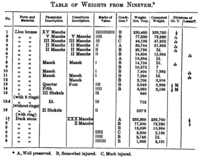Assyrian lion weights

Three of the lion weights in the British Museum. The table below lists all the known lion and duck weights from Nimrud as of the late 19th century.
|
|
 |
|
| Material | Bronze |
|---|---|
| Writing | Phoenician language and cuneiform |
| Created | c. 800–700 BC |
| Discovered | 1845–51 |
| Present location | British Museum |
| Identification | ME 91220 |
The Assyrian lion weights are a group of bronze Mesopotamian weights from the 8th century BCE, with bilingual inscriptions in both cuneiform and Phoenician characters. The lion weights were discovered at Nimrud in the late 1840s and are now in the British Museum.
The weights date from the 8th century BCE and they have bilingual inscriptions in both cuneiform and Phoenician characters. The Phoenician inscriptions are epigraphically from the same period as the Mesha Stele. They are one of the most important groups of artifacts evidencing the "Aramaic" form of the Phoenician script. At the time of their discovery, they were the oldest Phoenician-style inscription that had been discovered.
The set form a regular series diminishing in size from 30 cm to 2 cm in length. The larger weights have handles cast on to the bodies, and the smaller have rings attached to them. The group of weights also included stone weights in the shape of ducks. The weights represent the earliest known uncontested example of the Aramaic numeral system. Eight of the lions are represented with the only known inscriptions from the short reign of Shalmaneser V. Other similar lion weights were excavated at the Iranian site of Susa in 1901 by the French archaeologist Jacques de Morgan and are now in the Louvre in Paris.
There are two known systems of weights and measures from the ancient Middle East. One system was based on a weight called the mina which could be broken down into sixty smaller weights called shekels. These lion weights, however, come from a different system which was based on the heavy mina which weighed about a kilogram. This system was still being used in the Persian period and is thought to have been used for weighing metals.
...
Wikipedia
